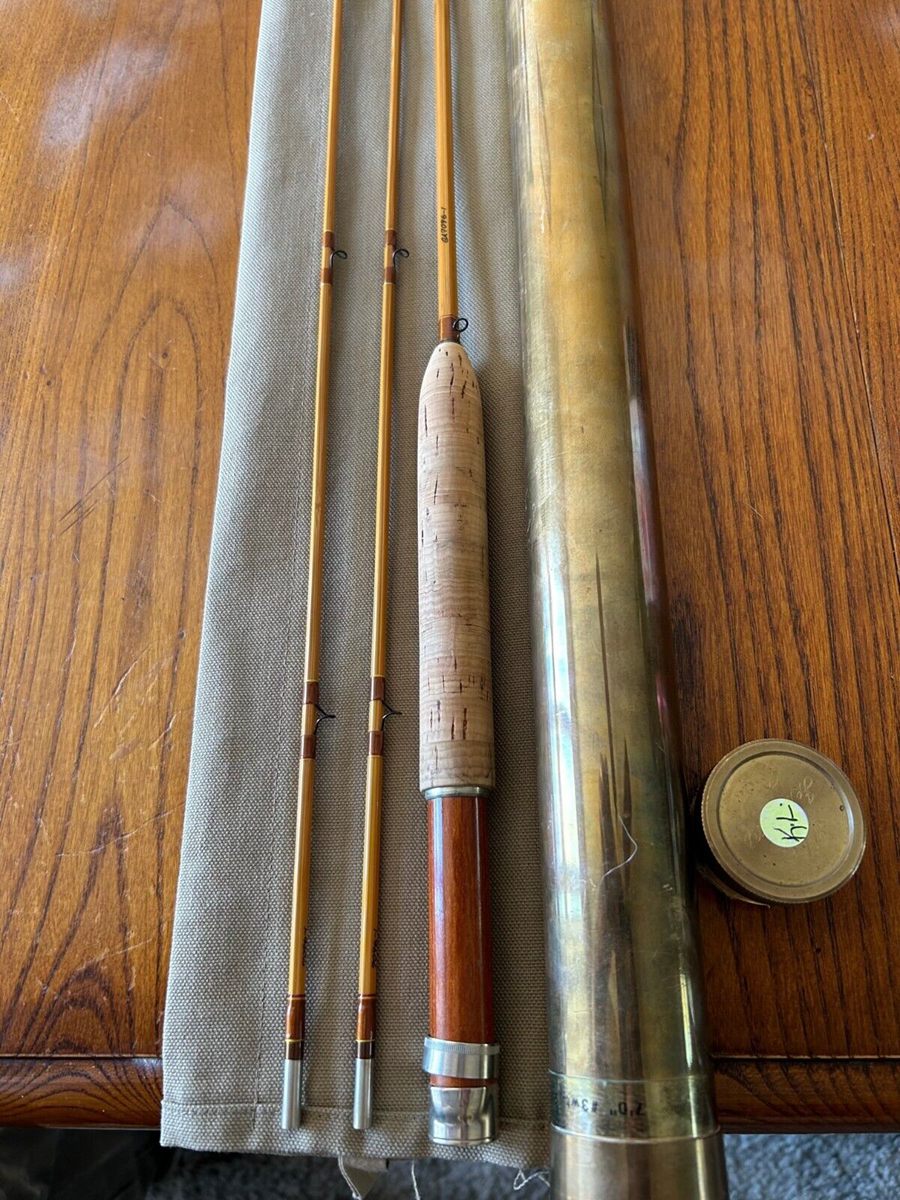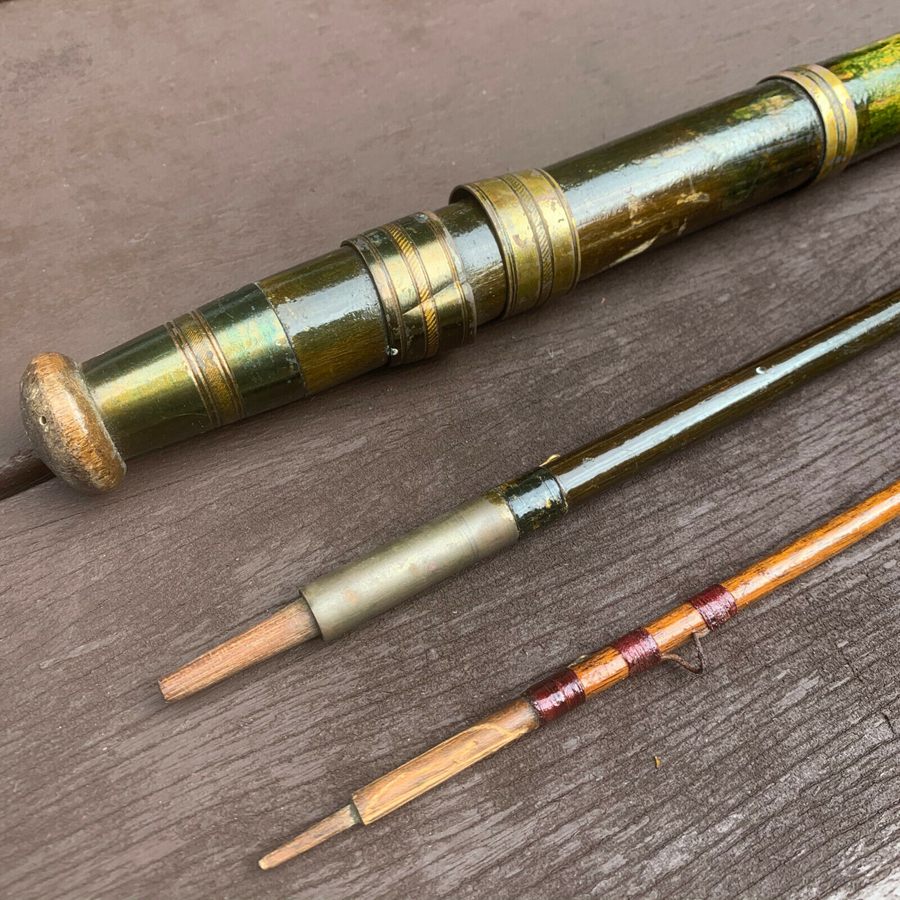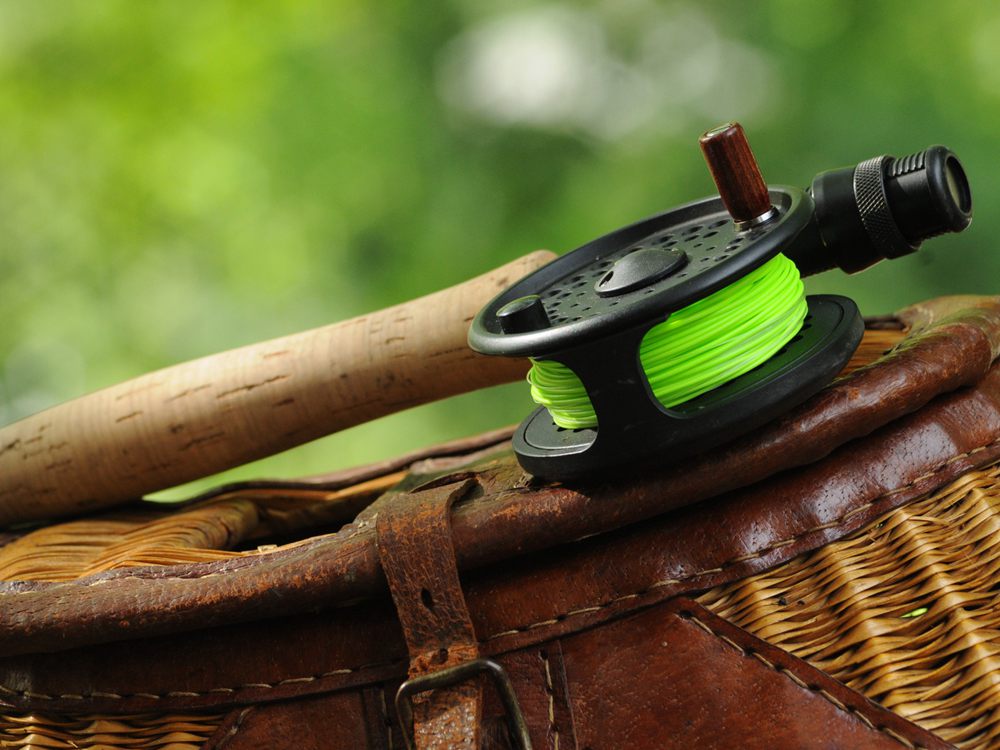Antique fishing rods hold a special place in the hearts of collectors and anglers alike. Not only do these vintage rods possess a unique aesthetic and sentimental value, but they may also have significant monetary worth. As you embark on your journey to learn more about antique fishing rods, this identification and price guide will support you every step of the way, providing key insights and information to help you make knowledgeable decisions.
When it comes to identifying antique rods, attention to detail is crucial. You’ll need to carefully examine each rod in your collection—or those you’re considering purchasing—to ensure you’re aware of its characteristics and potential value. Don’t worry if this task seems daunting at first, for with time and practice, you’ll become an expert at spotting the vital details that make each rod stand out.
Remember, factors such as rod length, manufacturer, and condition can significantly impact the price of an antique fishing rod. As you explore this guide and gain more knowledge about these rods, you’ll be better equipped to navigate the world of antique fishing rods and appreciate the value they bring both in function and as timeless pieces of history.
Table of Contents
The History & Evolution of Antique Fishing Rods
Fishing has been an essential activity for human beings since ancient times. The history of fishing rods, like any other tool, evolves with our needs and techniques. In this section, you will discover the fascinating journey of fishing rods from their early beginnings to what we know today.
The earliest known fishing rods date back to ancient Egypt, around 2000 BC. These early rods were made from reeds, creating a long and flexible tool for catching fish. As time progressed, new materials such as bamboo and eventually wood were introduced to make rods more durable and efficient.
During the medieval period in Europe, rods saw significant advancements in design and materials. European tackle makers began using materials like wood, whalebone, and polished steel, with lances serving as early precursors to the present-day fishing rod.
The Industrial Revolution brought revolutionary changes to the production of fishing rods. In the late 18th century, Britain experienced a boom in recreational fishing. To meet the growing demand for versatile and sturdy fishing rods, the split-cane rod was developed during this time. Split-cane rods were made from strips of bamboo glued together, giving anglers a flexible yet strong tool for their fishing needs.
Throughout the 19th century and the early 20th century, materials such as fiberglass and graphite were introduced, providing fishermen with even more durable and lightweight options. These advancements allowed fishing rods to evolve further, with different types of rods tailored to specific fishing styles and techniques.
When identifying and pricing antique fishing rods, keep in mind the following factors:
- Materials: Consider the type and quality of materials used. For example, a rare split-cane rod with intricate details would command a higher price.
- Age: Generally, the older a rod is, the more valuable it may be, especially if accompanied by documentation or a distinguished provenance.
- Condition: Look for signs of wear, damage, and restoration work – these can significantly impact the value of an antique fishing rod.
- Maker: Renowned tackle makers command higher prices than unknown or less celebrated craftsmen.
As you explore the world of antique fishing rods, you will gain a deeper understanding of the rich history and gradual evolution of these essential tools. This knowledge will not only help you identify and value your antique rods but also connect you to the centuries-long tradition of anglers and craftsmen who have shaped the art of fishing as we know it today.
How to Tell if a Fishing Rod is Antique or Old
When trying to determine if a fishing rod is an antique or simply old, consider the following factors:
Materials
Take note of the materials used to construct the rod. Antique fishing rods typically utilize materials like bamboo, wood, fiberglass, and early metals. They might also have features such as brass or nickel fittings. If you notice modern materials like graphite or carbon fiber, it’s likely not an antique.
Maker’s Marks
Examine the rod for any maker’s marks or labels. Many antique fishing rod manufacturers, like R.L. Winston or H.L. Leonard, would leave their marks or logos on their creations. Identifying a well-known maker’s mark can be a strong indicator that the rod is an antique. Do some research on vintage fishing rod brands to familiarize yourself with their marks and logos.
Overall Condition
Evaluate the overall condition of the rod. Although antique rods can still be in good shape, they are likely to show signs of age. Look for indications like faded labels, tarnished fittings, and worn handles. Of course, some old rods might have been well-maintained or restored, but visible signs of age can help you decide if a rod is antique or not.
Seek Expert Advice
Don’t hesitate to consult experts and collectors who are familiar with antique fishing rods. They can provide valuable insight into the rod’s age, materials, and rarity. Online forums and communities dedicated to classic fishing gears are excellent resources for gaining knowledge and asking questions.
Remember, not all old rods are valuable antiques. By considering the rod’s materials, maker’s marks, overall condition, and seeking expert advice, you’ll be well on your way to determining if a fishing rod is indeed antique or simply old.
5 Types of Antique Fishing Rods and Their Values
In this section, we will explore various types of antique fishing rods, their characteristics, and their values.
Bamboo Fly Rods

Bamboo fly rods are highly sought after by collectors, as they were made from light, tough, and pliable bamboo. Some popular antique fly rod manufacturers are Gary Howells, HL Leonard Hunt, Ed Fody, Vintage Hardy J J H, and Wright & McGill Granger. When identifying and evaluating bamboo fly rods, consider factors like:
- Material: Authentic bamboo rods have a unique construction and appearance.
- Age: Older rods typically have higher value.
Make sure to thoroughly inspect your bamboo rod for its markings, as they can provide more information about the rod’s history and value.
Greenheart Rods

Greenheart rods are a bit older than bamboo rods and were made from the Lancewood and Greenheart trees. These antique fishing rods were often spliced together from different types of wood for their strength and flexibility. The value of Greenheart rods depends on factors such as:
- Age: The older the rod, the higher its value.
- Rarity: Rarity often increases the value.
- Condition: Rods in good condition are worth more.
Split Cane Rods
Split cane rods are a form of bamboo fly rod, but they’re created by splitting the bamboo into narrow strips and then gluing those together to form the rod. Split cane rods are highly valued by collectors due to their craftsmanship and unique construction. When evaluating split cane rods, consider:
- Manufacturer: High-quality brands fetch higher prices.
- Age: Older split cane rods typically command a higher value.
- Condition: Well-maintained rods are worth more.
Solid Fiberglass Rods
Solid fiberglass rods were made in the 1950s, and while they may not be as collectible as bamboo or split cane rods, there are exceptions. Rods crafted by Russ Peak and Vince Cummings are highly valued, with worth ranging from $700 to $2,500. To determine the value of a solid fiberglass rod, consider:
- Brand: High-quality brands will have higher value.
- Age: Some older fiberglass rods may command a higher price.
- Rarity: Rare, limited-edition rods are worth more.
Metal Casting Rods

Metal casting rods, while not as popular as their wooden counterparts, can have value for a collector. These rods were typically made from steel or aluminum, providing durability and strength. When determining the value of a metal casting rod, consider:
- Manufacturer: Rods from well-known manufacturers will have higher value.
- Age: Older metal casting rods may be harder to find and therefore more valuable.
- Condition: Like any antique, condition plays a critical role in determining value.
Remember to research your fishing rods thoroughly and consult reliable sources, to ensure accurate identification and valuation.
4 Factors to Identify & Value Fishing Rod
1. Vintage Fishing Rod Materials
When identifying and pricing antique fishing rods, it is crucial to consider the materials used, as they significantly impact the value. This section outlines various materials used in vintage fishing rods and their average valuations.
Bamboo Fishing Rods
Bamboo rods are highly sought after for their craftsmanship and unique feel. Some well-known manufacturers of bamboo rods include Russ Peak and Vince Cummings. Here’s a table depicting the average valuation of bamboo fishing rods:
| Bamboo Rod Quality | Average Valuation |
|---|---|
| Mint Condition | $700 – $2,500 |
| Excellent Condition | $500 – $1,000 |
| Good Condition | $250 – $500 |
Fiberglass Fishing Rods
Fiberglass rods generally hold less value than bamboo rods, but some exceptions exist, such as those made by Russ Peak and Vince Cummings. Here is the valuation table for fiberglass spinning rods:
| Fiberglass Rod Condition | Average Valuation |
|---|---|
| Mint Condition | $100 – $350 |
| Excellent Condition | $50 – $200 |
| Good Condition | $25 – $100 |
Carbon Fiber (Graphite) Fishing Rods
Carbon fiber or graphite rods typically have the lowest collectible value due to their more modern production era. However, some vintage carbon fiber rods might still generate interest. The pricing for carbon fiber spinning rods is as follows:
| Carbon Fiber Rod Condition | Average Valuation |
|---|---|
| Mint Condition | $75 – $250 |
| Excellent Condition | $40 – $150 |
| Good Condition | $20 – $75 |
2. Vintage Fishing Rod Brands
When considering antique fishing rod values, certain brands can significantly impact the worth of an antique spinning wheel. Here are a few key brands that you should be aware of when looking to identify and price vintage fishing rods:
- Hardy
- Orvis
- Montague
- Heddon
- Leonard
- Payne
- South Bend
Each of these brands is known for their craftsmanship, quality, and historical significance in the world of fishing. To help you better understand how the brand affects the value of antique spinning wheels, let’s take a look at the average valuations for each of these brands:
| Brand | Average Valuation |
|---|---|
| Hardy | $400 – 600 |
| Orvis | $300 – 500 |
| Montague | $200 – 350 |
| Heddon | $250 – 400 |
| Leonard | $450 – 600 |
| Payne | $350 – 550 |
| South Bend | $150 – 300 |
Please note that these are only average valuations and that the actual value of a vintage fishing rod can vary depending on factors such as condition, rarity, and provenance. Always consult with an expert or conduct thorough research when looking to buy or sell these antique fishing rods, as the value can fluctuate significantly.
3. Antique Fishing Rod’s Condition
When valuing antique fishing rods, several factors come into play. The rod’s condition is one of the most important aspects to consider. The following table demonstrates how various conditions can affect the average valuation of these collectibles.
| Rod Condition | Average Valuation |
|---|---|
| Perfect Condition with no signs of wear or use | $500 – $600 |
| Working and in very good condition, lightly used with minimal signs of wear | $450 – $500 |
| Working and clearly looked after with general signs of use | $350 – $400 |
| Working but with signs of heavy use/wear and tear | $250 – $300 |
| Working but needs refurbishing/restoring | $100 – $150 |
| Incomplete/Scratched/Damaged/Not Working | $50 – $75 |
Apart from the rod’s condition, other factors like rarity, age, and manufacturer also play a crucial role in determining its value. Keep in mind that collectors often place a premium on rods that are completely original and in mint condition.
When identifying an antique fishing rod, pay close attention to its material, craftsmanship, and any unique features it may possess. Look for signs of age, such as patina or wear on metal parts, and any manufacturer’s marks or logos.
To ensure an accurate valuation, consider seeking the help of a professional appraiser with experience in antique fishing rods. They can provide expert guidance on the rod’s value based on the current market and its potential appeal to collectors. Remember, preserving the rod’s condition and maintaining its authenticity will be key in maximizing its value for years to come.
4. Antique Fishing Rod Rarity
When determining the value of antique fishing rods, the rarity of a particular rod is a crucial factor. This rarity often depends on factors such as the age, material, and brand of the fishing rod, as well as its overall condition.
Older fishing rods generally hold more value than their more recent counterparts. The following table shows the average valuation of fishing rods based on their age:
| Age Period | Average Valuation |
|---|---|
| Pre-1900 | $800 – $1,000 |
| 1900 – 1930 | $600 – $800 |
| 1930 – 1950 | $400 – $600 |
| 1950 – 1970 | $200 – $400 |
Final Thoughts
When it comes to identifying antique fishing rods, it’s essential to examine the materials used, the maker’s marks or signatures, and the condition of the rod. Remember that rods made before 1950 can be considered antiques, and those made of bone, bamboo, or wood from the 1800s are particularly valuable.
Investing time and effort in researching the history and maker’s marks can pay off significantly, providing you with insights into the value and rarity of your fishing rod. Be on the lookout for notable manufacturers such as Heddon or Montague, as they are often considered more valuable.
As you delve into the world of antique fishing rods, be aware of potential replicas or fakes. Familiarize yourself with typical rod-making techniques and materials of that era to avoid any possible misidentification. Additionally, be cautious about any restoration work that has been done, as that might decrease the value of the rod.
When determining the price of an antique fishing rod, consider factors such as condition, rarity, and the overall collector’s market. Consulting a price guide or online resources can assist you in determining its value. However, it’s worth noting that the market is ever-changing, so stay updated on current trends and pricing.
In conclusion, identifying and pricing antique fishing rods might require patience and research, but having a keen eye for detail will aid you in discovering their true worth. Enjoy expanding your knowledge and exploring this fascinating area of collecting.
FAQ
What factors affect the value of an antique fishing rod?
When identifying and valuing antique fishing rods, some key factors to consider are:
- Age: Older rods, particularly those made of bone or bamboo, are often more valuable.
- Manufacturer: Certain well-known manufacturers, such as Gary Howells, HL Leonard, Ed Fody, Hardy, and Wright & McGill, are more desirable for collectors.
- Material: The type of material used, such as bamboo, can affect the value.
- Condition: The condition of the rod greatly impacts its value, with well-maintained rods fetching higher prices.
- Length: Rods under eight feet in length are typically more sought-after and may sell for significantly more than longer rods from the same maker.
How can I identify the manufacturer of my antique fishing rod?
To identify the manufacturer of your antique fishing rod, look for any markings or labels on the rod itself. Many manufacturers will have their name or logo printed or engraved on the rod. Additionally, you can research different manufacturers and compare the features of their rods to the one you have.
Where can I sell my antique fishing rod?
There are several places where you can sell your antique fishing rod:
- Auction houses: Some auction houses specialize in antique sporting goods and may be interested in your rod.
- Online marketplaces: Websites like eBay and Etsy allow you to sell your antique fishing rod to collectors worldwide.
- Swap meets and antique shows: These events are great places to connect with collectors and other sellers in person.
- Antique shops: Some local antique dealers may be interested in buying your fishing rod, particularly if it is in good condition and from a desirable manufacturer.
Remember that the value of your rod will depend on its condition, age, manufacturer, and other factors, so it’s essential to do your research and set a reasonable price.









